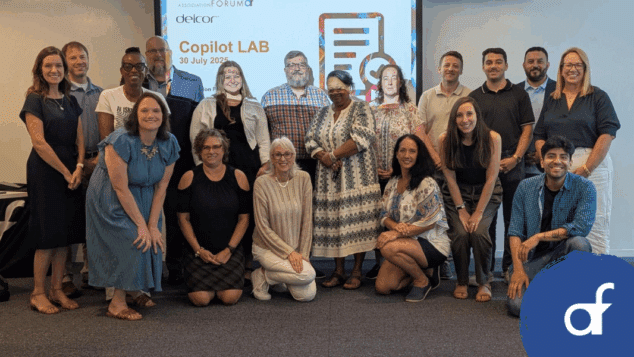The Do’s and Don’ts of Cutting-edge Event Tech

Picture this: Event attendees stand on a balcony, overlooking their peers on the convention center’s floor. Amid branded signs for the association’s event and its sponsors, the attendees roam past multiple doors leading to presenters’ booths. Then they enter the general session, sitting in the third row.
That all might seem like a typical event experience — except it’s entirely digital. “It replicates the experience of a live event,” says Bryan Sterling, group director, global sales, Encore. A global provider of event technology and production services, Encore has created similarly immersive experiences for large associations.
Once the pandemic disrupted live events, associations had to undergo a crash course in the technology that can enable and even enhance virtual and, more recently, hybrid events.
“We did nothing virtual before, and then we went 100% virtual immediately,” says Margaret Mueller, president and CEO, Executives’ Club of Chicago, which presents thought leadership, leadership development and industry events.
The pandemic has compelled associations to think carefully about events and their purpose. For years, many had presented the same event format, time after time. “COVID-19 forced people to step back and say, ‘How can I make this more interesting?’” says Francesca Radabaugh, COO and president of association management, Paragon Events, a Florida-based event-planning firm.
Now, nearly two years into the new normal, the pluses and minuses of various tech options have become clear.
The who and why
Technology should follow the event’s purpose — not the other way around. According to association leaders and event planners, whiz-bang technology isn’t always the best option.
Associations should begin with a clear understanding of who their members are and what they — and the associations — want to get out of the event. Is the event simply providing educational sessions? Is it offering a networking space? Such questions will help point associations toward the tech they actually need.
Immersive or 3D events might be fun, but they’re not for everyone. For one thing: “They are costly and time-consuming to create,” Radabaugh says.
Executives’ Club of Chicago explored robust custom platforms that can offer immersive options. “It’s really cool to virtually enter and roam through different rooms, but it’s cost-prohibitive for us,” Mueller says. An immersive experience, she adds, makes more sense for a single event that convenes thousands of people over a few days. It makes less sense for the Executives’ Club, which hosts over 100 events every year, each for hundreds of people.
“It’s not only cost-prohibitive,” Mueller adds, “but it’s also not the way people engage with an association like ours.”
If association members don’t work with computers every day or aren’t tech-savvy, an immersive experience might not serve them well — and might not be the best use of association funds. Special VR headsets, for instance, can quickly become very expensive.
“Know your audience and be cognizant of what’s a necessity and what’s a nice-to-have, and make decisions accordingly,” Radabaugh says.
During the recent transition from all virtual to a virtual/in-person hybrid mix, associations should understand that different audiences have different needs. An in-person attendee likely would sit through a 90-minute event. A virtual attendee probably won’t want to stare at a screen for that long.
“You have to start with the goals of each audience, what each audience wants from the event, and then work backward,” Sterling says.
Don’t break the budget
The costs of tech-driven events can add up fast. In addition to foregoing fancy but unnecessary tech, associations can keep costs low by using a mix of recorded and live programs. For a hybrid association event this fall, Encore live-streamed only the plenary session and recorded the breakout sessions. This saved the association on internet and streaming services.
“The more you can front-end load and then let the show run, the more cost-effective it can be,” Paragon’s Radabaugh says.
In part, that’s because it takes more staff to present live sessions online. Paragon has three workers run live sessions: one who sees everything attendees see and the other two on the technical back end. But the company has just two workers for recorded sessions: one in front, the other in back.
Also, some platforms are more custom and costly than others. Some event platforms, such as Cvent, offer self-service options that can allow associations to save money by doing some of the work in-house — such as uploading content or managing the attendee list.
Have fun with features
Over the past two years, Paragon Events has researched and tested more than 40 virtual platform providers, including Cvent, Social27 and vFairs. Each platform has its own features — such as breakout rooms, interactive sponsor booths and round-robin Q&A sessions. “These features are great for longer, multi-day programs as they help break up the content,” Radabaugh says.
Similarly, Encore, which has its own platform called Chime, offers virtual exhibits and interactive tools such as push polls, surveys and quizzes. Any or all can be deployed for any event. “When it comes to virtual platforms, one size doesn’t fit all,” says Rob Wilcox, director, sales engineering, Encore.
Such features can be used to break up the rhythm and inject a little fun into larger, more formal events — and that can go a long way toward battling Zoom fatigue. Paragon, for example, has put together events that include virtual bingo tournaments, industry-specific trivia nights and mixology classes.
This year, for a national legal association’s annual conference that included about 65 education sessions, 150 speakers and over 1,100 attendees, Paragon knew it had to do something extra to keep attendees interested. So it used the platform vFairs to integrate recorded entertainment breaks, as well as a live-streamed session featuring Vice President Kamala Harris.
Beyond the platform, an event producer like Encore can provide a studio environment that gives virtual events a professional, polished look. It can also coach the presenters and provide onscreen graphics.
Although it considered various platforms, the Executives’ Club decided to handle its annual events in-house, using programs such as GoToWebinar and Zoom. But it also created and hired a new position: a digital events producer.
Getting engaged
The point of event tech isn’t the tech itself. It’s how well it helps engage members. “Everyone’s biggest concern with virtual events is engagement and finding ways to keep the audience interested and feeling connected,” Radabaugh says.
At an association’s virtual awards event this year, Encore helped keep attendees engaged with an interactive feature: When attendees hovered their cursors over the award nominees, an animation appeared along with the nominee’s profile.
After shifting from in-person to virtual, the Executives’ Club doubled the number of people attending its events— from about 9,000 people a year to about 18,000.
In a member survey conducted in March 2021, the Executives’ Club found that 80% of members wanted events to return to in-person and that 80% also wanted to keep having virtual events. “They’re telling us they want all of it,” Mueller says.
Event tech can also bolster in-person engagement. This summer, for a regional apartment management association’s first in-person trade show in over a year, Paragon replaced paper handouts with QR codes on all the event signage, so attendees could scan the codes to find the event agenda and other information. Paragon also used the app BadgerScan so attendees could exchange contact info without having to handle business cards or pens.
Taking the test
Regardless of the tech that’s used, virtual and hybrid events need more time to plan, build and test. That should involve an end-to-end test of the entire event: “The biggest thing we’ve learned with these new technologies is testing is key,” Radabaugh says.
But a test can only be effective if all the presenters attend it. “The No. 1 piece of advice that I cannot stress strongly enough is you have to make everyone show up to the tech test — and it has to be on the computer and microphone they will be using at the event,” Mueller says.
Her organization learned that early in the pandemic. Presenters would say they couldn’t make the tech test. They’d insist they used similar tech all the time and they wouldn’t have a problem. Or they might attend the test but use their home computer and then use their work computer for the event. “Inevitably, something failed,” Mueller says.
As part of its tests, the Executives’ Club ensures that each participant has the dial-in number on hand. So even if they lose their video connection, they can at least participate by phone. “That’s better than wasting time trying to figure out how to get the platform working,” Mueller says.
Tags
Related Articles
The Power of Taking the AI Journey Together
Forum’s first Microsoft Copilot Lab brought together 20 professionals to explore how smart adoption of...
What to Wear to the Honors Gala 2025: SHINE ON in Style
Get ready to sparkle, shimmer, and most importantly—shine! Association Forum’s Honors Gala 2025 is on…
Protecting Healthcare: Tackling Cyber Threats to Hospitals and Patients
The critical role of cybersecurity in healthcare and association management.




